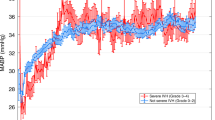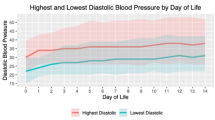Abstract
Objective
To evaluate whether treated hypotension in the first 24 postnatal hours is associated with hearing loss in extremely low birth weight (ELBW) infants.
Study design
In a cohort of 735 ELBW infants, we identified 25 with sensorineural hearing loss (SNHL) at 12–24 months adjusted age. For each case, we selected three controls with normal hearing. Logistic regression models were used to adjust for confounding variables.
Results
Sixty percent of cases and 25% of controls were treated for hypotension. After adjusting for confounding variables (gestational age, antenatal glucocorticoids, 5 min Apgar < 6, insertion of an umbilical catheter, treatment with high frequency ventilation, and major cranial ultrasound abnormality), treated hypotension was associated with an increased risk of SNHL (adjusted odds ratio: 3.6; 95% confidence interval: 1.3–9.7).
Conclusions
Treated hypotension in ELBW infants in the first 24 h of life is associated with an increased risk of SNHL.
This is a preview of subscription content, access via your institution
Access options
Subscribe to this journal
Receive 12 print issues and online access
$259.00 per year
only $21.58 per issue
Buy this article
- Purchase on Springer Link
- Instant access to full article PDF
Prices may be subject to local taxes which are calculated during checkout

Similar content being viewed by others
References
Vohr B. Speech and language outcomes of very preterm infants. Semin Fetal Neonatal Med. 2014;19:78–83.
Xoinis K, Weirather Y, Mavoori H, Shaha SH, Iwamoto LM. Extremely low birth weight infants are at high risk for auditory neuropathy. J Perinatol. 2007;27:718–23.
Laughon M, Bose C, Allred E, O'Shea TM, Van Marter LJ, Bednarek F, et al. Factors associated with treatment for hypotension in extremely low gestational age newborns during the first postnatal week. Pediatrics. 2007;119:273–80.
St Peter D, Gandy C, Hoffman SB. Hypotension and adverse outcomes in prematurity: comparing definitions. Neonatology. 2017;111:228–33.
Weindling AM, Wilkinson AR, Cook J, Calvert SA, Fok TF, Rochefort MJ. Perinatal events which precede periventricular haemorrhage and leukomalacia in the newborn. Br J Obstet Gynaecol. 1985;92:1218–23.
Low JA, Froese AB, Galbraith RS, Smith JT, Sauerbrei EE, Derrick EJ. The association between preterm newborn hypotension and hypoxemia and outcome during the first year. Acta Paediatr. 1993;82:433–7.
Fanaroff JM, Wilson-Costello DE, Newman NS, Montpetite MM, Fanaroff AA. Treated hypotension is associated with neonatal morbidity and hearing loss in extremely low birth weight infants. Pediatrics. 2006;117:1131–5.
Fanaroff AA, Fanaroff JM. Short- and long-term consequences of hypotension in ELBW infants. Semin Perinatol. 2006;30:151–5.
Synnes AR, Anson S, Baum J, Usher L. Incidence and pattern of hearing impairment in children with ≤800 g birthweight in British Columbia, Canada. Acta Paediatr. 2012;101:e48–54.
Hintz SR, Kendrick DE, Wilson-Costello DE, Das A, Bell EF, Vohr BR, et al. Early-childhood neurodevelopmental outcomes are not improving for infants born at <25 weeks' gestational age. Pediatrics. 2011;127:62–70.
Wynn JL, Wong HR, Shanley TP, Bizzarro MJ, Saiman L, Polin RA. Time for a neonatal-specific consensus definition for sepsis. Pediatr Crit Care Med. 2014;15:523–8.
Stoll BJ, Hansen NI, Sanchez PJ, Faix RG, Poindexter BB, Van Meurs KP, et al. Early onset neonatal sepsis: the burden of group B Streptococcal and E. coli disease continues. Pediatrics. 2011;127:817–26.
Gopel W, Berkowski S, Preuss M, Ziegler A, Kuster H, Felderhoff-Muser U, et al. Mitochondrial mutation m.1555A>G as a risk factor for failed newborn hearing screening in a large cohort of preterm infants. BMC Pediatr. 2014;14:210.
Vohr BR, Wright LL, Dusick AM, Mele L, Verter J, Steichen JJ, et al. Neurodevelopmental and functional outcomes of extremely low birth weight infants in the National Institute of Child Health and Human Development Neonatal Research Network, 1993-1994. Pediatrics. 2000;105:1216–26.
Morris BH, Oh W, Tyson JE, Stevenson DK, Phelps DL, O'Shea TM, et al. Aggressive vs. conservative phototherapy for infants with extremely low birth weight. N Engl J Med. 2008;359:1885–96.
Doyle LW, Roberts G, Anderson PJ. Changing long-term outcomes for infants 500-999 g birth weight in Victoria, 1979-2005. Arch Dis Child Fetal Neonatal Ed. 2011;96:F443–7.
Vohr BR, Widen JE, Cone-Wesson B, Sininger YS, Gorga MP, Folsom RC, et al. Identification of neonatal hearing impairment: characteristics of infants in the neonatal intensive care unit and well-baby nursery. Ear Hear. 2000;21:373–82.
de Hoog M, van Zanten BA, Hop WC, Overbosch E, Weisglas-Kuperus N, van den Anker JN. Newborn hearing screening: tobramycin and vancomycin are not risk factors for hearing loss. J Pediatr. 2003;142:41–6.
Wang LA, Smith PB, Laughon M, Goldberg RN, Ku LC, Zimmerman KO, et al. Prolonged furosemide exposure and risk of abnormal newborn hearing screen in premature infants. Early Hum Dev. 2018;125:26–30.
Lestner JM, Hill LF, Heath PT, Sharland M. Vancomycin toxicity in neonates: a review of the evidence. Curr Opin Infect Dis. 2016;29:237–47.
Kraft CT, Malhotra S, Boerst A, Thorne MC. Risk indicators for congenital and delayed-onset hearing loss. Otol Neurotol. 2014;35:1839–43.
Dempsey EM, Barrington KJ. Treating hypotension in the preterm infant: when and with what: a critical and systematic review. J Perinatol. 2007;27:469–78.
Bada HS, Korones SB, Perry EH, Arheart KL, Ray JD, Pourcyrous M, et al. Mean arterial blood pressure changes in premature infants and those at risk for intraventricular hemorrhage. J Pediatr. 1990;117:607–14.
Low JA, Froese AB, Smith JT, Galbraith RS, Sauerbrei EE, Karchmar EJ. Hypotension and hypoxemia in the preterm newborn during the four days following delivery identify infants at risk of echosonographically demonstrable cerebral lesions. Clin Investig Med. 1992;15:60–5.
Miall-Allen VM, de Vries LS, Whitelaw AG. Mean arterial blood pressure and neonatal cerebral lesions. Arch Dis Child. 1987;62:1068–9.
Watkins AM, West CR, Cooke RW. Blood pressure and cerebral haemorrhage and ischaemia in very low birthweight infants. Early Hum Dev. 1989;19:103–10.
Dammann O, Allred EN, Kuban KC, Van Marter LJ, Pagano M, Sanocka U, et al. Systemic hypotension and white-matter damage in preterm infants. Dev Med Child Neurol. 2002;44:82–90.
Limperopoulos C, Bassan H, Kalish LA, Ringer SA, Eichenwald EC, Walter G, et al. Current definitions of hypotension do not predict abnormal cranial ultrasound findings in preterm infants. Pediatrics 2007;120:966–77.
Logan JW, O'Shea TM, Allred EN, Laughon MM, Bose CL, Dammann O, et al. Early postnatal hypotension and developmental delay at 24 months of age among extremely low gestational age newborns. Arch Dis Child Fetal Neonatal Ed. 2011;96:F321–8.
Logan JW, O'Shea TM, Allred EN, Laughon MM, Bose CL, Dammann O, et al. Early postnatal hypotension is not associated with indicators of white matter damage or cerebral palsy in extremely low gestational age newborns. J Perinatol. 2011;31:524–34.
Murphy DJ, Hope PL, Johnson A. Neonatal risk factors for cerebral palsy in very preterm babies: case-control study. BMJ. 1997;314:404–8.
Goldstein RF, Thompson RJ Jr., Oehler JM, Brazy JE. Influence of acidosis, hypoxemia, and hypotension on neurodevelopmental outcome in very low birth weight infants. Pediatrics. 1995;95:238–43.
Hunt RW, Evans N, Rieger I, Kluckow M. Low superior vena cava flow and neurodevelopment at 3 years in very preterm infants. J Pediatr. 2004;145:588–92.
Pirodda A, Ferri GG, Modugno GC, Gaddi A. Hypotension and sensorineural hearing loss: a possible correlation. Acta Oto-Laryngol. 1999;119:758–62.
Maass B. Autonomic nervous system and hearing. Adv Oto-Rhino-Laryngol. 1981;27:14–25.
Acknowledgements
This research was supported by the North Carolina Department of Health and Human Services and the National Institutes of Health (U10 HD40498).
Author information
Authors and Affiliations
Corresponding author
Ethics declarations
Conflict of interest
The authors declare that they have no conflict of interest.
Additional information
Publisher’s note Springer Nature remains neutral with regard to jurisdictional claims in published maps and institutional affiliations.
Rights and permissions
About this article
Cite this article
Gogcu, S., Washburn, L. & O’Shea, T.M. Treatment for hypotension in the first 24 postnatal hours and the risk of hearing loss among extremely low birth weight infants. J Perinatol 40, 774–780 (2020). https://doi.org/10.1038/s41372-020-0628-y
Received:
Revised:
Accepted:
Published:
Issue Date:
DOI: https://doi.org/10.1038/s41372-020-0628-y
This article is cited by
-
Hemodynamic Quality Improvement Bundle to Reduce the Use of Inotropes in Extreme Preterm Neonates
Pediatric Drugs (2022)
-
Maximum vasoactive-inotropic score and mortality in extremely premature, extremely low birth weight infants
Journal of Perinatology (2021)



